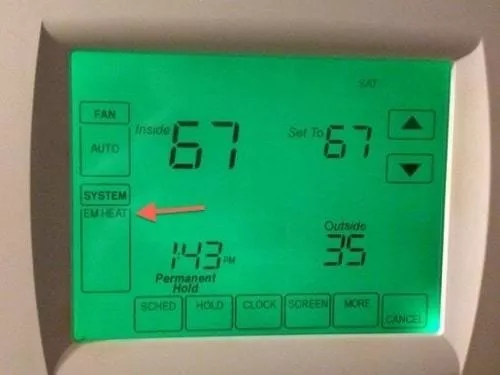What Is EM Heat and When Should I Use It?

When the weather turns cold, your heat pump does the heavy lifting to keep you and your family warm and cozy inside your home. While adjusting the thermostat, you may have noticed the EM heat setting and asked yourself, "What is EM heat?" The short answer is that this setting is available when you need emergency heat, and a few situations make this feature a very useful option.
It's a good idea to know all the features available within your HVAC system, so keep reading to learn the difference between EM heat vs. heat and how this setting can help you get the most out of your heat pump.
- What Is EM Heat?
- How EM Heat Works
- When to Use EM Heat
Trust the experts at Jon Wayne for all your heating and cooling needs.
When looking for reliable heat pump repair service, you can count on Jon Wayne’s NATE-certified technicians to get the job done right the first time. Our 100% satisfaction guarantee is reflected in thousands of 5-star reviews from our happy customers.
What Is EM Heat?
"EM Heat" stands for Emergency Heat, and it’s a feature found in some heat pump systems. Heat pumps are designed to efficiently transfer heat between indoor and outdoor environments to both cool and heat a space. However, in extremely cold weather conditions, the efficiency of a heat pump can decrease, as there is less ambient heat available for it to extract from the outdoor air.
To address this issue, heat pump systems often have an auxiliary or backup heating system, which is activated when the outdoor temperatures drop significantly. This backup heating system is EM Heat. It typically involves electric resistance heating elements that can provide heat even when the heat pump's efficiency is compromised.
That said, it's important to use this setting minimally, as electric resistance heating is generally less energy-efficient and more expensive than the heat pump's normal operation. It’s recommended to use the EM Heat setting only when necessary, such as during extremely cold weather or if the heat pump is experiencing issues.
How EM Heat Works
Your thermostat is designed with both automatic triggers and a manual setting for engaging EM Heat. This allows you the flexibility to activate EM Heat whenever you deem it essential. You might use EM Heat as a secondary source of warmth if your heat pump is not operational or in conjunction with your heat pump for an extra boost of heat. However, it's crucial to understand that manually turning on EM Heat will lead your thermostat to disable the heat pump, preventing it from operating simultaneously. To have both your heat pump and EM Heat work together, you'll need to rely on the thermostat's automatic settings.
When to Use EM Heat
Understanding when to utilize the EM Heat setting is key. Remember, EM Heat stands for 'Emergency Heat' and is aptly named for its intended use during specific scenarios. Given that using EM Heat can be more expensive than running your heat pump due to its higher operational costs, it's wise to use this feature carefully. Here's a look at scenarios where turning on EM Heat might be necessary.
Extreme Cold Weather
When temperatures sink close to zero, you might notice a little chill in your home. While heat pumps are incredibly efficient, they can struggle when the weather gets extreme. You can set the temperature threshold to alert your thermostat to kick on the EM heat to help maintain your set temperature.
Heat Pump Malfunction
Heat pumps are designed to efficiently heat your home by transferring heat from the outside air, even in cold temperatures. However, if the heat pump is damaged, fails, or simply cannot operate effectively due to extreme cold weather, it may not provide sufficient warmth to maintain comfortable indoor temperatures.
In such instances, activating the EM Heat setting is a practical solution. It allows your heating system to bypass the non-functional heat pump and directly engage a secondary heating source. This secondary source is typically more energy-intensive, hence the designation 'emergency' due to the higher cost of operation. Utilizing EM Heat ensures that your home remains warm and comfortable until the heat pump can be repaired or until outdoor temperatures rise to levels where the heat pump can resume efficient operation.
Power Outages
While EM Heat might not be the first solution that comes to mind, given that it typically requires electricity to operate, there are scenarios where it can be beneficial.
If your home is equipped with a backup power source, such as a generator capable of powering your heating system, switching to EM Heat during a power outage can be a wise decision. This is particularly true if the outage affects the operation of your heat pump, either due to the pump's inability to function without electricity or because the external conditions have rendered the heat pump inefficient or unable to operate.
In these circumstances, EM Heat can provide a reliable alternative heating solution, ensuring that your home remains warm until the primary power supply is restored and your heat pump can function normally again. It's important to note, however, that because EM Heat operates at a higher cost, its use should be carefully considered based on the duration of the outage and the capacity of your backup power source.
Utilizing EM Heat during a power outage underscores the importance of a versatile and well-prepared home heating system, ready to adapt to unexpected situations while keeping your living space comfortable and safe.
Don't get left in the cold. Contact Jon Wayne Service Company when your heat pump needs attention.
The loyalty of our customers is rooted in our commitment to honesty and integrity in everything we do. When you're ready to schedule your heat pump repair, we'll provide you with upfront pricing so there are no budget surprises once the work is complete.

